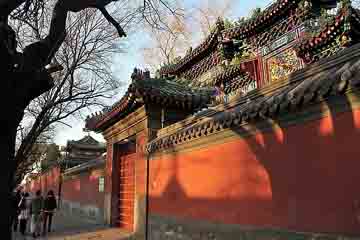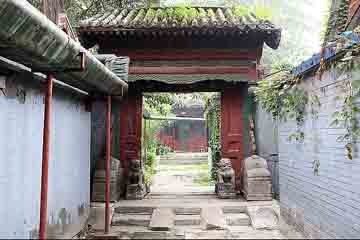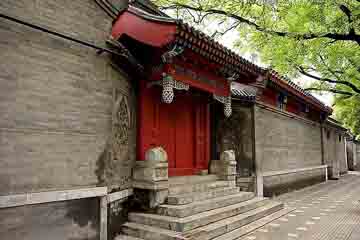Home > Attractions >
Beijing Hutongs
A hutong is an ancient city alley or lane typical in Beijing, where hutongs run into the several thousand. Surrounding the Forbidden City, many were built during the Yuan (1206-1341), Ming(1368-1628) and Qing(1644-1908) dynasties. In the prime of these dynasties the emperors, in order to establish supreme power for themselves, planned the city and arranged the residential areas according to the etiquette systems of the Zhou Dynasty. The center of the city of Beijing was the royal palace -- the Forbidden City.One kind of hutongs, usually referred to as the regular hutong, was near the palace to the east and west and arranged in orderly fashion along the streets. Most of the residents of these hutongs were imperial kinsmen and aristocrats. Another kind, the simple and crude hutong, was mostly located far to the north and south of the palace. The residents were merchants and other ordinary people.
The main buildings in the hutong were almost all quadrangles--a building complex formed by four houses around a quadrangular courtyard . The quadrangles varied in size and design according to the social status of the residents. The big quadrangles of high- ranking officials and wealthy merchants were specially built with roof beams and pillars all beautifully carved and painted, each with a front yard and back yard. However, the ordinary people's quadrangles were simply built with small gates and low houses. hutongs, in fact, are passageways formed by many closely arranged quadrangles of different sizes. The specially built quadrangles all face the south for better lighting; as a result, a lot of hutongs run from east to west. Between the big hutongs many small ones went north and south for convenient passage.
At the end of the Qing Dynasty unified and closed China came under influence from abroad, having experienced change of dynasties and the vicissitudes of life. The stereotyped arrangement of the hutong was also affected. Many newly formed hutongs with irregular houses appeared outside the city, while many old ones lost their former neat arrangement. The social status of the residents also changed, reflecting the collapse of the feudal system. During the period of the Republic of China (1911-1948), Chinese society was unstable, with frequent civil wars and repeated foreign invasions.
The city of Beijing deteriorated, and the conditions of the hutong worsened. Quadrangles previously owned After the founding of the people's Republic of China in 1949, hutong conditions improved. In recent years, the houses in many hutongs have been pulled down and replaced by modern buildings. Many hutong dwellers have moved to new housing.
The hutong today is fading into the shade for both tourists and inhabitants.
However, in the urban district of Beijing houses along hutongs still occupy one third of the total area, providing housing for half the population, so many hutongs have survived. In this respect, we see the old in the new in Beijing as an ancient yet modern city.
The main buildings in the hutong were almost all quadrangles--a building complex formed by four houses around a quadrangular courtyard . The quadrangles varied in size and design according to the social status of the residents. The big quadrangles of high- ranking officials and wealthy merchants were specially built with roof beams and pillars all beautifully carved and painted, each with a front yard and back yard. However, the ordinary people's quadrangles were simply built with small gates and low houses. hutongs, in fact, are passageways formed by many closely arranged quadrangles of different sizes. The specially built quadrangles all face the south for better lighting; as a result, a lot of hutongs run from east to west. Between the big hutongs many small ones went north and south for convenient passage.
At the end of the Qing Dynasty unified and closed China came under influence from abroad, having experienced change of dynasties and the vicissitudes of life. The stereotyped arrangement of the hutong was also affected. Many newly formed hutongs with irregular houses appeared outside the city, while many old ones lost their former neat arrangement. The social status of the residents also changed, reflecting the collapse of the feudal system. During the period of the Republic of China (1911-1948), Chinese society was unstable, with frequent civil wars and repeated foreign invasions.
The city of Beijing deteriorated, and the conditions of the hutong worsened. Quadrangles previously owned After the founding of the people's Republic of China in 1949, hutong conditions improved. In recent years, the houses in many hutongs have been pulled down and replaced by modern buildings. Many hutong dwellers have moved to new housing.
The hutong today is fading into the shade for both tourists and inhabitants.
However, in the urban district of Beijing houses along hutongs still occupy one third of the total area, providing housing for half the population, so many hutongs have survived. In this respect, we see the old in the new in Beijing as an ancient yet modern city.






